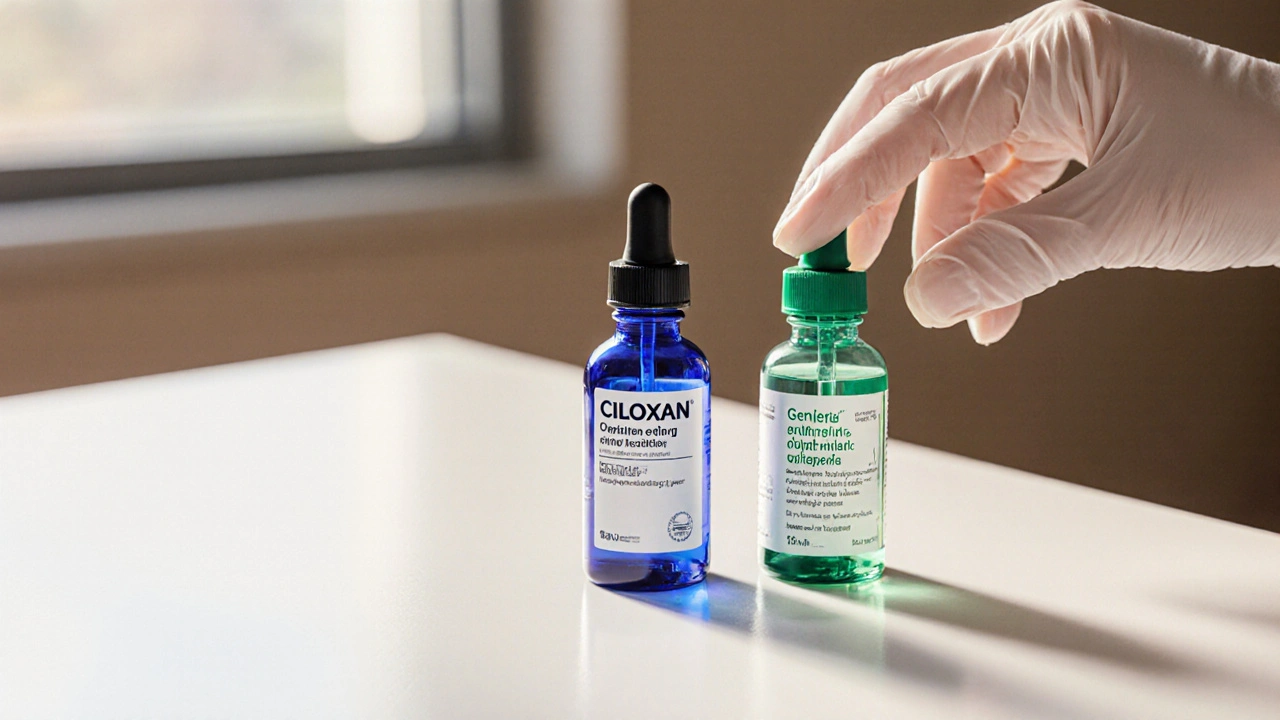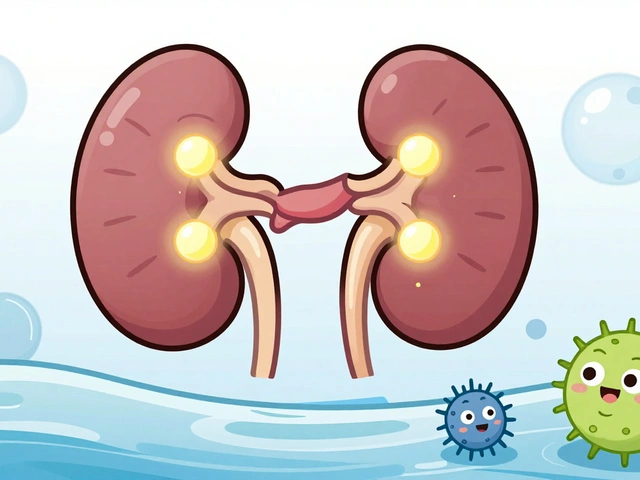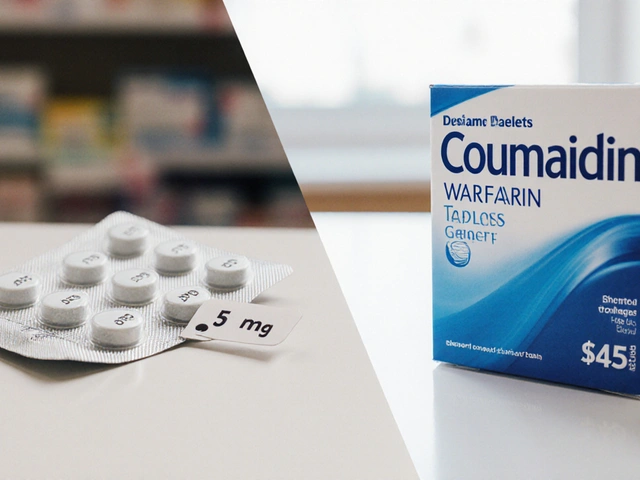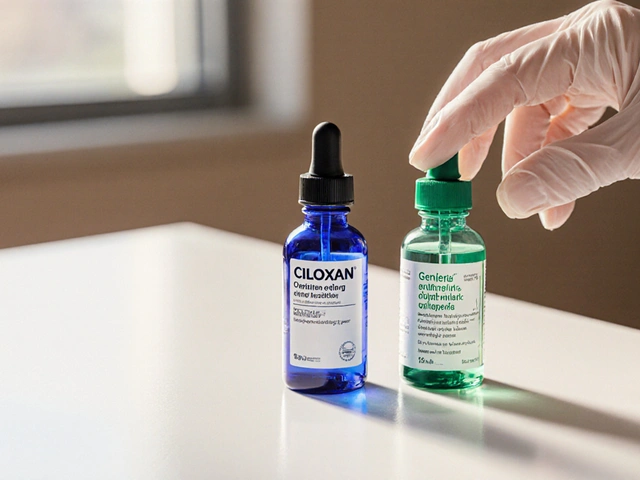Eye Drop Choice Advisor
Choose Your Scenario
When you’re dealing with an eye infection, the choice of drops can feel overwhelming. Ciloxan Ophthalmic Solution is a ciprofloxacin hydrochloride eye drop used for bacterial conjunctivitis and corneal ulcers. Knowing how it stacks up against the other go‑to eye‑drops helps you (or your clinician) pick the right one fast.
TL;DR - Quick Takeaways
- Ciloxan offers broad‑spectrum coverage and is usually dosed four times a day.
- Besifloxacin (Besivance) is the most potent fluoroquinolone, but costs more.
- Ofloxacin (Ocuflox) provides a similar spectrum to Ciloxan with twice‑daily dosing for some cases.
- Tobramycin is an aminoglycoside best for gram‑negative infections and works well with contact‑lens wearers.
- Moxifloxacin (Vigamox) is a once‑daily option for patients who need convenience.
What Is Ciloxan Really?
Ciloxan contains ciprofloxacin hydrochloride 0.3%, a synthetic fluoroquinolone that interferes with bacterial DNA gyrase. It’s approved in Australia under the TGA for acute bacterial conjunctivitis, keratitis, and post‑surgical prophylaxis. The typical regimen is one drop in the affected eye(s) every 2‑4hours for the first 48hours, then four times daily for a total of 7days.
Key Alternatives on the Market
Below are the most commonly prescribed ophthalmic antibiotics in Australian practice.
- Besifloxacin - marketed as Besivance (0.6% fluoroquinolone).
- Ofloxacin - sold as Ocuflox (0.3% fluoroquinolone).
- Tobramycin - an aminoglycoside (0.3%).
- Moxifloxacin - Vigamox (0.5% fluoroquinolone).
- Chloramphenicol - a broad‑spectrum bacteriostatic eye drop (0.5%).
Side‑by‑Side Comparison
| Active Ingredient | Typical Dosing | Coverage Spectrum | Cost (AU$) - 7days | Common Side Effects |
|---|---|---|---|---|
| Ciprofloxacin (Ciloxan) | QID → QD after 48h | Gram‑neg & some gram‑pos | ≈$12 | Burning, mild irritation |
| Besifloxacin | QD × 7days | Broad‑spectrum, excellent MRSA coverage | ≈$45 | Transient stinging |
| Ofloxacin | QID → BID after 48h | Gram‑neg, some gram‑pos | ≈$15 | Temporary blurred vision |
| Tobramycin | QID → BID after 72h | Primarily gram‑neg (Pseudomonas) | ≈$8 | Allergic conjunctivitis |
| Moxifloxacin | QD × 7days | Broad, strong against resistant strains | ≈$30 | Rare intra‑ocular inflammation |
| Chloramphenicol | QID → BID after 48h | Broad, but not Pseudomonas | ≈$10 | Potential bone‑marrow suppression (rare) |

When to Choose Ciloxan Over the Rest
Think of Ciloxan as the all‑rounder. It’s a solid pick when you need:
- A cost‑effective option (PBS subsidised for many patients).
- Broad coverage that includes Bacterial conjunctivitis caused by Haemophilus influenzae or Streptococcus pneumoniae.
- Convenient access - most pharmacies stock it without a special order.
If the infection is linked to contact lens wear or you suspect Pseudomonas aeruginosa, a fluoroquinolone with stronger anti‑Pseudomonal activity (e.g., Besifloxacin or Moxifloxacin) might be safer. For patients allergic to fluoroquinolones, Tobramycin or Chloramphenicol become viable alternatives.
Practical Checklist for Clinicians and Patients
- Confirm the diagnosis. Differentiate bacterial from viral or allergic conjunctivitis - look for purulent discharge and eyelid crusting.
- Assess risk factors. Contact‑lens wear, recent eye surgery, or immunosuppression push you toward a higher‑potency fluoroquinolone.
- Check allergies. Ask about previous reactions to fluoroquinolones or aminoglycosides.
- Consider cost and PBS status. Ciloxan is often subsidised, whereas Besifloxacin isn’t.
- Review dosing convenience. Patients struggling with four‑times‑daily regimens may benefit from once‑daily options like Moxifloxacin.
- Schedule follow‑up. Re‑evaluate after 48‑72hours; lack of improvement may signal resistant organisms.
Potential Pitfalls & How to Avoid Them
- Incorrect dosing. Skipping the intensive first 48‑hour phase can lead to sub‑therapeutic exposure and resistance.
- Self‑medication. Over‑the‑counter availability in some pharmacies tempts patients to use drops without professional guidance - always confirm the infection type first.
- Cross‑contamination. Inadequate bottle hygiene can re‑introduce bacteria; advise patients to avoid touching the tip to the eye.
- Resistance development. Repeated use of fluoroquinolones, especially without culture, can select for resistant strains. Reserve high‑potency agents for proven cases.
Frequently Asked Questions
Can I use Ciloxan for viral pink eye?
No. Ciprofloxacin targets bacteria. Viral conjunctivitis usually clears on its own or needs antiviral therapy. Using an antibiotic unnecessarily can foster resistance.
Is Ciloxan safe for children?
Yes, Ciloxan is approved for pediatric use down to 2years of age, provided the dosing schedule is followed. Always check weight‑based dosing if your doctor recommends it.
How long does it take to feel better?
Most patients notice reduced redness and discharge within 24‑48hours. Full resolution typically needs the full 7‑day course.
Can I wear contact lenses while using Ciloxan?
Remove lenses during treatment and wait at least 15minutes after each drop. Re‑insert only after the infection clears to avoid re‑contamination.
What if I miss a dose?
Take the missed dose as soon as you remember, unless it’s almost time for the next one. Then skip the missed dose - don’t double‑dose.
Bottom Line
Choosing the right eye‑drop comes down to infection type, patient preferences, and cost. Ciloxan Ophthalmic Solution offers a reliable, affordable baseline for most bacterial eye infections, while newer fluoroquinolones or aminoglycosides fill niche roles when you need extra potency or a simplified regimen.







September 28, 2025 AT 06:39
The pharmaceutical giants have been quietly engineering eye‑drop formulas for decades, embedding hidden markers that only the deep‑state labs can decode. Every time a new fluoroquinolone hits the shelves, a silent data point is uploaded to a central server that tracks ocular microbiome shifts worldwide. What most patients don’t realize is that the so‑called “broad‑spectrum” label is a myth manufactured to sell higher‑priced generic versions. The ingredient list on Ciloxan’s bottle masks a trace amount of stabilizer that, when combined with contact lens wear, creates a micro‑environment perfect for resistant Pseudomonas strains. Moreover, the dosing schedule-four drops a day initially-was deliberately designed to keep users glued to the product longer, ensuring more data collection points. If you compare the cost of Ciloxan with the newer Besifloxacin, the price gap isn’t just about profit; it’s a calculated incentive to push clinicians toward a drug that has a built‑in back‑door for surveillance. The Australian TGA approval process is another layer of obfuscation, relying on data supplied by the same multinational corporations that own the patents. It’s not a coincidence that the same batch numbers appear on shipments destined for both urban hospitals and remote clinics, creating a uniform data set across divergent populations. When a patient misses a dose, the pharmaceutical data logs register a compliance failure, which is then fed into predictive models used by insurance companies to adjust premiums. The alleged “once‑daily” convenience of Moxifloxacin is actually a marketing ploy that hides a formulation that degrades faster on the eye surface, forcing patients to buy refills sooner. Even the “burning” sensation reported by many Ciloxan users is a signal from the drug’s carrier molecules, warning the body of the unseen chemical exchange taking place. If you look at the literature, you’ll see that the majority of studies cited in the product’s monograph are funded by the manufacturer itself, raising serious questions about bias. The so‑called “broad‑coverage” claim especially overstates efficacy against gram‑positive organisms, which in reality require a different class of antibiotic altogether. This hidden agenda extends to the recommended practice of removing contact lenses during treatment, a step that conveniently creates another sales opportunity for disposable lenses. Critics who point out these inconsistencies are often silenced through professional societies that receive funding from the same drug companies. The bottom line is that the eye‑drop market is a tightly controlled ecosystem where every choice you make feeds into a larger surveillance network. Understanding these hidden mechanisms empowers patients to question the default prescription and seek alternatives that are truly independent of corporate influence.